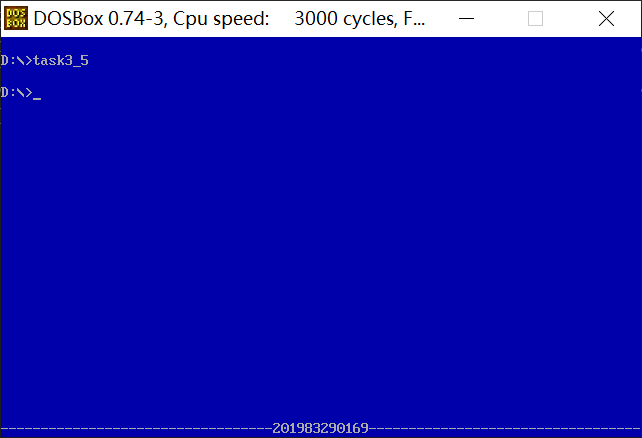Experiment task 1:
assume cs:code, ds:data data segment x db 1, 9, 3 len1 equ $ - x y dw 1, 9, 3 len2 equ $ - y data ends code segment start: mov ax, data mov ds, ax mov si, offset x mov cx, len1 mov ah, 2 s1:mov dl, [si] or dl, 30h int 21h mov dl, ' ' int 21h inc si loop s1 mov ah, 2 mov dl, 0ah int 21h mov si, offset y mov cx, len2/2 mov ah, 2 s2:mov dx, [si] or dl, 30h int 21h mov dl, ' ' int 21h add si, 2 loop s2 mov ah, 4ch int 21h code ends end start
① line27, when the assembly instruction loop s1 jumps, it jumps according to the displacement. Check the machine code through debug disassembly and analyze the jump displacement? (the displacement value is answered in decimal) from the perspective of the CPU, explain how to calculate the offset address of the instruction after the jump label s1.
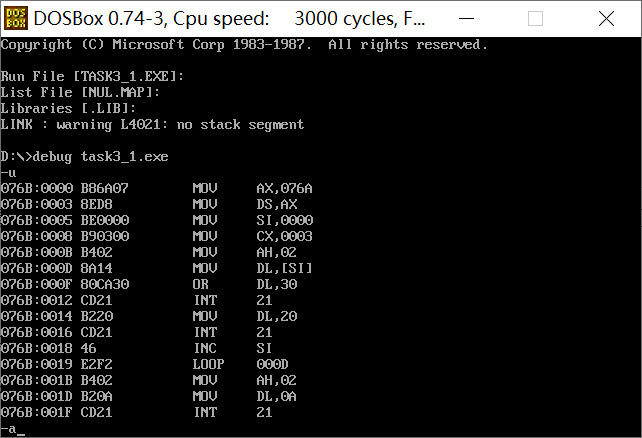
According to the disassembly, you can see that the machine code of the loop instruction is "E2F2", and F2 is the complement form of the displacement, which is converted to decimal is - 14, that is, the jump displacement.
The offset address of the next instruction of the loop instruction is 001B, plus the jump displacement, that is, 001B-E=000D, which is just the offset address of the label S1 instruction.
② line44. When the assembly instruction loop s2 jumps, it jumps according to the displacement. Check the machine code through debug disassembly and analyze the jump displacement? (the displacement value is answered in decimal) from the perspective of the CPU, explain how to calculate the offset address of the instruction after the jump label s2.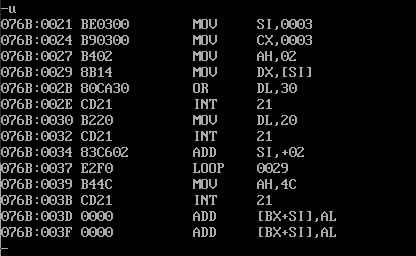
According to the disassembly, we can see that the loop machine code is "E2F0", and F0 is the complement form of the displacement, which is converted to decimal is - 16, that is, the jump displacement.
The offset address of the next instruction of the loop instruction is 0039, plus the jump displacement, that is, 0039-0010 = 0029, which is just the offset address of the label S2 instruction.
Experiment task 2:
assume cs:code, ds:data data segment dw 200h, 0h, 230h, 0h data ends stack segment db 16 dup(0) stack ends code segment start: mov ax, data mov ds, ax mov word ptr ds:[0], offset s1 mov word ptr ds:[2], offset s2 mov ds:[4], cs mov ax, stack mov ss, ax mov sp, 16 call word ptr ds:[0] s1: pop ax call dword ptr ds:[2] s2: pop bx pop cx mov ah, 4ch int 21h code ends end start
① According to the jump principle of call instruction, it is analyzed theoretically that before the program executes to exit (line31), register (ax) =? Register (bx) =? Register (cx) =?
The first call instruction puts the offset of the instruction s1 after it on the stack, jumps to the code executing s1, takes the top byte of the stack out of the stack and assigns it to ax, which is the offset of the s1 tag address
The second call instruction successively puts the segment address cs of the current code segment and the offset address of the next instruction s2 on the stack, and then jumps to the code executing s2. First assign the offset address of s2 to bx, and then assign the segment address cs to cx. Therefore, bx is the offset address marked by s2, and cx is the segment address of cs
② Assemble and link the source program to get the executable program task2.exe. Use debug to observe and verify whether the debugging results are consistent with the theoretical analysis results.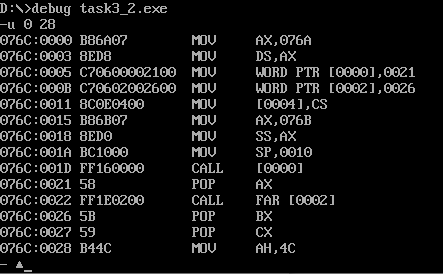
It can be seen that at the beginning, the offset address of mark s1 is 0021, the segment address of mark s2 is 076c, and the offset address is 0026

After execution, you can see ax=0021, bx=0026, cx=076c
Experiment task 3:
assume cs:code, ds:data data segment x db 99, 72, 85, 63, 89, 97, 55 len equ $- x data ends code segment start: mov ax, data mov ds, ax mov si, 0 mov cx, len s: mov ah, 0 mov al, [si] inc si call printNumber call printSpace loop s mov ah, 4ch int 21h printNumber: mov bl, 10 div bl mov bx, ax mov ah, 2 add bl, 48 mov dl, bl ; int 21h add bh, 48 mov dl, bh ; int 21h ret printSpace: mov ah, 2 mov dl,' ' ; int 21h ret code ends end start
The experimental results are as follows:

Experiment task 4:
assume cs:code, ds:data data segment str db 'try' len equ $ - str data ends stack segment db 16 dup(0) stack ends code segment start: mov ax, data mov ds, ax mov ax,0b800h mov es,ax mov si,offset str mov cx,len mov bl,2 mov bh,0 call printStr mov si,offset str mov cx,len mov bl,4 mov bh,24 call printStr mov ah, 4ch int 21h printStr: mov al,bh push bx mov bl,160 mul bl mov di,ax pop bx s:mov al,[si] mov es:[di],al mov es:[di+1],bl inc si add di,2 loop s ret code ends end start
The experimental results are as follows:
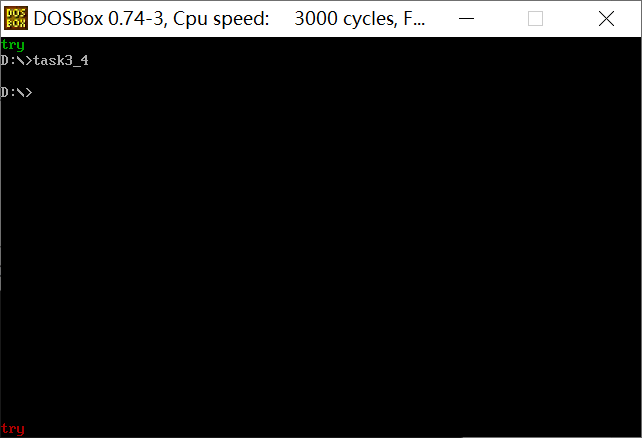
Experiment task 5:
assume cs:code, ds:data data segment stu_no db '201983290169' len = $ - stu_no data ends code segment start: mov ax, data mov ds, ax mov ax, 0b800h mov es, ax mov si, 1 mov cx, 7d0h ; s: mov byte ptr es:[si],17h ; add si, 2 loop s mov si, 0f00h mov cx, 80 s1: mov byte ptr es:[si], 2dh ; add si, 2 loop s1 mov si, 0f44h ; mov cx, 12 mov bx, 0 s2: mov al, [bx] mov es:[si], al add si, 2 inc bx loop s2 mov ax, 4c00h int 21h code ends end start
The experimental results are as follows:
